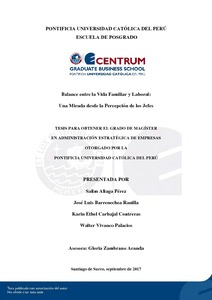| dc.contributor.advisor | Zambrano Aranda, Gloria María Regina | |
| dc.contributor.author | Aliaga Pérez, Salim | es_ES |
| dc.contributor.author | Barrenechea Ranilla, José Luis | es_ES |
| dc.contributor.author | Carbajal Contreras, Karin Ethel | es_ES |
| dc.contributor.author | Vivanco Palacios, Walter | es_ES |
| dc.date.accessioned | 2017-10-30T18:11:48Z | |
| dc.date.available | 2017-10-30T18:11:48Z | |
| dc.date.created | 2017 | |
| dc.date.issued | 2017-10-30 | |
| dc.identifier.uri | http://hdl.handle.net/20.500.12404/9600 | |
| dc.description.abstract | La presente es una investigación de tipo descriptivo, que tiene como objetivo
identificar la percepción que tienen los jefes sobre el balance de la vida familiar y laboral de
sus colaboradoras. La investigación tiene un enfoque cualitativo, utilizando el método de
casos múltiples con diferentes técnicas para recopilar la información como: (a) entrevistas a
profundidad, (b) notas de campo, y (c) observación. Para ello, se aplicó un protocolo de caso,
que incluye una guía de entrevista con preguntas abiertas para los 19 jefes, hombres mayores
de 30 años y con un mínimo de 10 colaboradores.
Los resultados de la investigación permiten concluir que los jefes perciben: (a) que
sus colaboradoras sí alcanzan un balance entre la vida familiar y laboral, y es un requisito
necesario que ellas sean eficientes en la administración de su tiempo, especialmente en el
horario de trabajo, enfocándose en el cumplimiento de sus funciones; (b) que no hay
diferencia alguna entre supervisar a hombres y mujeres, reconociendo que las mujeres son
detallistas y demandan un trato diferente; y (c) que la principal barrera es la carga de
responsabilidades que por tradición se le asigna a la mujer por los diferentes roles, en especial
a aquellas que son casadas, complicándose la situación con la llegada de los hijos.
Por lo tanto, las percepciones que tienen los jefes son valiosas para lograr el balance
entre la vida familiar y laboral de sus colaboradoras. Esto se refleja no solo en la cantidad de
tiempo que se dedica a la familia y al trabajo, sino también en la calidad de la dedicación que
se tiene en cada tarea. Lograr el balance contribuye a reducir el estrés y mejorar las
condiciones de salud, para lo cual las colaboradoras necesitan contar con el apoyo de la
pareja, tener una distribución equitativa de las responsabilidades familiares y, de ser posible,
contar con una persona que brinde asistencia con las tareas del hogar | es_ES |
| dc.description.abstract | This document constitutes a descriptive research with a qualitative approach, using
the case method, which aims to identify the perception of the leaders on the balance of work
and family life of its women employees. Different techniques have been used to gather
information, such as depth interviews, field notes and observation. This required a protocol
event, which includes an interview guide with open and closed questions that was applied to
bosses in Lima.
The results of the investigation leaded to the conclusion that bosses perceive: (a) That
women employed themselves reach a balance between work and family life, being a
necessary requirement that they are efficient in managing their time, especially in working
hours, focusing focus on meeting their functions; (b) that there is no difference between men
and women monitor, recognizing that women are more retailers and demand a more delicate
treatment; delicate in treatment, and (c) that the main barrier is the burden of responsibilities
traditionally assigned to women employed, especially those who are married, complicating
the situation with the arrival of children.
Therefore, perceptions of heads are valuable to achieve their collaborators’ life
balance work and family. This is reflected not only in the amount of time devoted to work
and family, but also in the dedication they have for each task. Achieving balance, it helps
reduce stress and improve health conditions for women employed which requires need to
have the support of the couple, to have a more equitable sharing of family responsibilities;
and if possible, have someone providing assistance with household chores | es_ES |
| dc.language.iso | spa | es_ES |
| dc.publisher | Pontificia Universidad Católica del Perú | es_ES |
| dc.rights | info:eu-repo/semantics/openAccess | es_ES |
| dc.rights.uri | http://creativecommons.org/licenses/by-nc-nd/2.5/pe/ | * |
| dc.subject | Mujeres -- Trabajo -- Perú | es_ES |
| dc.subject | Actitud (Psicología) | es_ES |
| dc.subject | Investigación cualitativa | es_ES |
| dc.title | Balance entre la vida familiar y laboral: una mirada desde la percepción de los jefes | es_ES |
| dc.type | info:eu-repo/semantics/masterThesis | es_ES |
| thesis.degree.name | Maestro en Administración Estratégica de Empresas | es_ES |
| thesis.degree.level | Maestría | es_ES |
| thesis.degree.grantor | Pontificia Universidad Católica del Perú. CENTRUM | es_ES |
| thesis.degree.discipline | Administración Estratégica de Empresas | es_ES |
| renati.discipline | 413307 | es_ES |
| renati.level | https://purl.org/pe-repo/renati/level#maestro | es_ES |
| renati.type | https://purl.org/pe-repo/renati/type#tesis | es_ES |
| dc.publisher.country | PE | es_ES |
| dc.subject.ocde | https://purl.org/pe-repo/ocde/ford#5.02.04 | es_ES |






